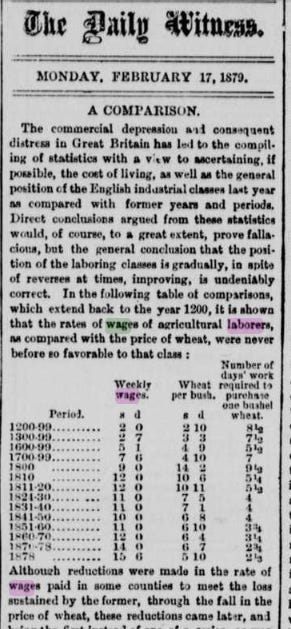For 800 Years Wheat Has Been Growing More Abundant As Population Increased
Malthus had it backwards. More people make food much more abundant.
In the 1200s in Great Britain it took 8.5 days of work to earn the money to buy one bushel of wheat. By 1878 the time had dropped 72.6 percent to 2.33 days. For the time it took to earn the money to buy one bushel in the 1200s you would get 3.65 bushels in 1878, a 265 percent increase in personal wheat abundance.
Population-level wheat abundance is equal to personal wheat abundance multiplied by population. Population in Great Britain increased 465 percent from around 4.23 million in the 1200s to 23.51 million in 1878. This would indicate that population-level wheat abundance increased 1,928 percent from an indexed value of one in the 1200s to 20.28 in 1878.
Tip of Hat: Vincent Geloso
Since 1900 wheat has become even more abundant as population has grown. Our analysis of 40 commodities from 1900 to 2018 shows a 96.7 percent drop in the time price of wheat for blue-collar workers.
Thanks for reading Gale Winds. Subscribe for free to receive new posts and support my work.
You can learn more about these economic facts and ideas in our new book, Superabundance, available at Amazon. Jordan Peterson calls it a “profoundly optimistic book.”
Gale Pooley is a Senior Fellow at the Discovery Institute and a board member at Human Progress.








Another great example of increasing abundance that more people need to be aware of. Just watched Planet of the Humans. It does a great job of showing the appalling idiocy and dishonesty behind many in the environmental movement, Bill McKibben and Al Gore most dramatically. Unfortunately, later it sinks into the usual doomer nonsense and never considers nuclear power.